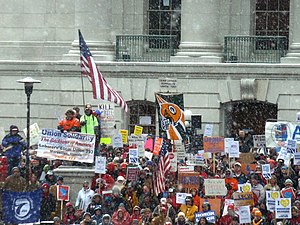2011 United States public employee protests
In February 2011, a series of public employee protests began in the United States against proposed legislation which would weaken the power of labor unions.
[1] The protests occurred when public employee unions mounted protests against legislation proposed by Republican governors such as Scott Walker (Wisconsin), Rick Scott (Florida), Mitch Daniels (Indiana), Sean Parnell (Alaska), Rick Snyder (Michigan), John Kasich (Ohio), Paul LePage (Maine) and Jan Brewer (Arizona) which, among other things, would strip public employees of some collective bargaining rights as well as require higher employee contributions to pension and health care plans.
The protests began in Wisconsin,[2][3] then spread to Indiana and Ohio, with unions around the country rallying to show their opposition to the proposed legislation.
[9] Representative Carl Gatto (R-Palmer), has introduced legislation that would strip many public employees of the right to collectively bargain for hours, benefits and working conditions.
[10] More info[1] Republicans in the Senate and Assembly have proposed measures that would limit collective-bargaining rights and increase pension contributions for state employees.
Democrats in control of the Legislature kept collective bargaining safe, but Governor Jerry Brown (D) unveiled a plan in March to target excesses in pensions.
[11] Los Angeles county police estimated that between 5,000 and 8,000 people took part in a protest against pay cuts to state workers on March 26.
A small group of union employees, nearing 100, marched in Palm Beach to show solidarity with Wisconsin workers on April 4, in honor of the anniversary of Martin Luther King Jr.'s death.
[11] More info[6] A bill restricting the collective bargaining rights’ of Idaho's unionized teachers passed the legislature on March 7 and was signed into effect by Republican Gov.
[11] Republican House members proposed a “right-to-work” bill that would have made it illegal for an employer to mandate that employees join a union.
[11] The Kansas House passed a Republican-backed bill on February 24 that would ban voluntary deductions from union members’ paychecks for political activities.
[9][11] Kansas union members filled the hall of the House on February 24 in an unsuccessful attempt to urge lawmakers to oppose the bill.
Scott Walker, who is trying to eliminate collective bargaining rights for public employees, and expressed support for right-to-work legislation proposals in the Maine Legislature.
The artist, Judy Taylor, stated, “There was never any intention to be pro-labor or anti-labor, it was a pure depiction of the facts.”[21] LePage also announced that he plans to rename conference rooms that have carried the names of historic leaders of American labor, including former Secretary Frances Perkins, the first female cabinet member in American history (Franklin Roosevelt's Secretary of Labor) who had strong Maine roots.
Democratic Governor Deval Patrick's agenda included proposals to restrict the collective bargaining power of municipal unions over health care plan design and to increase the retirement age in order to reduce the unfunded liability in the pension system.
Although Patrick supported limited restrictions on some aspects of health care plans for municipal employees, he has spoken against broader proposals against overall collective bargaining rights.
However, the legislation ran contrary to the national trend in which the Democratic Party at the federal and state level were opposing all measures to change collective bargaining rights.
[11] More info[6] Senate President Pro Tem Rob Mayer, a Republican, said on February 24 that he plans to propose a “right-to-work” bill next week.
[11] Wisconsin-style protests haven't occurred, but Senate President Rob Mayer told the St. Louis Post-Dispatch: “I’m aware that [protests] could take place and happen, but it will in no way keep me from moving forward with trying to implement the law.”[11] More info[6] A proposed bill and constitutional amendment introduced by State Senator John Nelson (Republican) called for abolishing collective bargaining and the Nebraska Commission of Industrial Relations.
In February, newly elected Republican Governor Brian Sandoval asked legislators to ignore his predecessor's collective-bargaining plan.
[11] Nevada's public employees held rallies in Carson City on April 4 to protest the proposed “attacks” on their rights.
The amendment text is as follows On March 30, the New Hampshire House of Representatives passed a bill that ended nearly all collective bargaining rights for state workers.
[28] On March 31, local religious leaders held a prayer and fasting vigil in the statehouse outside House Speaker Bill O'Brien's office.
[11] The state teachers union, police and firefighters, CWA and AFL-CIO planned to send protesters to a workers' rights rally at the Statehouse on June 16.
[31] More info[1] Republican Governor John Kasich supported a Senate bill (SB 5) that would eliminate collective bargaining for state-government employees.
[11] Amendments to collective bargaining have not come to fruition; about 400 demonstrators protesting budget cuts to state programs gathered at the Capitol on April 6.
[11][47][48] Protesters occupied the Wisconsin Capitol building to demonstrate their opposition to the proposed legislation restricting the collective bargaining rights of public employees and increase their share of benefits payments, and what they saw as anti-democratic behavior by the governor and legislature.
[50] Although many protesters did leave on Sunday afternoon at the urging of union leaders and Democrats,[citation needed] hundreds defied the order and remained in the building.
[51] The Department of Administration did not reopen the building until Tuesday nor remove the added security, such as metal detectors, for several weeks, in defiance of a court order.
A Burbank, California resident who sent a long email offering a $50,000 bounty for Walker was interviewed by federal agents who determined he was mentally challenged and not a true threat.


